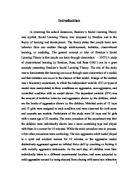Research support for deindividualisation theory
Rehm: Children divided randomly into five a side teams to play handball. One team played in normal clothes – other team played in orange shirts. Those who wore orange shirts played significantly more aggressively than thon those who wore their everyday clothes
Mann ’81 Analysed 21 suicide reports in newspapers. In ten cases identified a ‘baiting' crowd e.g. shouting jump. Baiting more likely to occur at night with a large crowd and when there was some distance between the crowd and the person threatening suicide. (NB This is another example of the archival method which probably made use of content analysis).
Zimbardo 1970: Anonymous lab coat experiment. Woman dressed in white lab-coats and hoods – anonymous. Control wore ordinary clothes and name tags. Similar to Milgram’s study - participants had to shock a victim. Anonymous participants shocked longer (more painfully). Anonymity contributed to aggressive behaviour. Evaluation: Klu Klux Klan effect: Association with KKK may have affected intensity of the shocks given rather than anonymity; Nurses in uniform shocked less in an equivalent experiment; Sample entirely women; Unethical – lacked informed consent and protection from harm.
Research challenging deindividualisation theory
Gergen et al. (1973) Darkened room arousal study. Gergen looked at the effect of anonymity on deindividualisation. Male and female students interact for an hour in an environmental chamber. No rules. Afterwards they leave alone with no interactions. There were two conditions: lights on; total darkness (anonymous) Lit room condition: participants found the study boring – no hugging! Dark room condition: half hugged 89% intentionally touched reported experience to be sensuous and fun. Many volunteered again. The conclusion deindividualisation leads to freeing of inhibitions, not necessarily aggression. This is evidence against deindividualisation theory of aggression. In fact it’s an example of anonymity leading to a pro-social act. Note: The study is low in ecological validity, it is artificial and involves a small number of participants.
Evaluation of deindividualisation
Can you think of an example where people act pro-socially in a large group or crowd? E.g. pop concerts, peace rallies, natural disaster, large gatherings for religious festival. Clearly deindividualisation doesn’t always lead to anti-social behaviour. A meta-analysis of 60 studies looking at crowd behaviour and deindividualisation concluded there was insufficient support for the theory. Deindividualisation doesn’t always lead to aggression, in fact it can at times lead to increased pro-social behaviour.
Collective unconscious theory Le Bon
Men undergo a radical transformation in a crowd. Individuals in a crowd lose their conscious individual personalities to the primitive, animalistic spirit of the crowd. Individuals in a crowd descend ‘several rungs in the ladder of civilisation’ showing impulsive, irritable, highly suggestible and overly emotional behaviour and an incapacity to reason
The mechanisms of what happens 1) Anonymity: due to sheer numbers the individuals, the crowd feels a sense of invincible power along with a lack of responsibility. 2) Contagion: crowd behaviour spreads amongst its members like an involuntary disease 3) Suggestibility: the suggestions of crowd members or leaders are accepted uncritically due to loss of conscious personality
The crowd has the following effect upon its members: 1) Homogeneity of personality: all members behave in the same way. 2) Intellectual retardation: Crowds are intellectually inferior to the individuals who compose it, showing rapid shifts of attention and acceptance of ideas in the absence of evidence. 3) Violent action: with a loss of constraint, savage and destructive behaviour is shown. 4) Exaggerated emotionalism: Crowd members become excited and impulsive
Evaluation of theory: 1) Reporting – unscientific based largely on anecdotal evidence 2) LeBon contrasts the irrationality of the crowd with a model of normal isolated people – lone individuals can be just as irrational, stupid and emotional 3) LeBon does not distinguish between types of crowds e.g. often peaceful gathered for the purpose of enjoyment and celebration 4) Explanations of crowds being mobs serves the political purpose of denying crowd action about legitimate concerns. 5) Others challenge theory, suggesting that crowd behaviour is not wild and unruly and does not involve a loss of identity.








